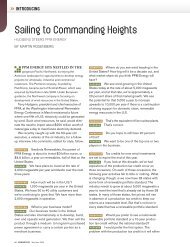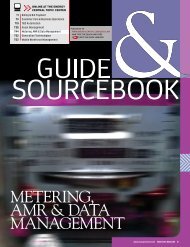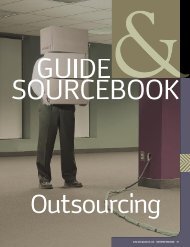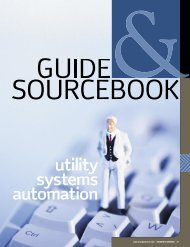CEO Turnover - Description
CEO Turnover - Description
CEO Turnover - Description
You also want an ePaper? Increase the reach of your titles
YUMPU automatically turns print PDFs into web optimized ePapers that Google loves.
good. I don’t see a billing system as necessarily<br />
a strategic IT investment as much<br />
as it is a commodity kind of investment.<br />
Of course I’m speaking in terms of a regulated<br />
utility business. Having more fixed<br />
technologies and being able to provide<br />
standards within the application, with a<br />
variety of billing options, is good. CIS is<br />
such a huge part of an IT infrastructure<br />
within a utility. Integration of that back<br />
to service, to work orders, wireless, back<br />
to all the technologies and applications<br />
across the company is a point of success<br />
for a CIS system. And having all that integration<br />
sitting there waiting for us is a<br />
good point. Now what starts driving you<br />
away from it is the thought that you’re<br />
going to buy best-of-breed applications.<br />
But I think with today’s technology,<br />
they’re building that type of integration<br />
back to their tool sets. They’re probably<br />
doing it in standard tool sets so you can<br />
still attach a best-of-breed off the edge<br />
of it, so I think it’s good.<br />
WOO: In Ontario there have been some<br />
implementations of CIS in the last two or<br />
three years, brought about by our market<br />
opening. All the utilities in Ontario<br />
are considering consolidating their back<br />
offices, including CIS. We’re in discussions<br />
about that now, so we will be interested<br />
in what’s available when those decisions<br />
are made. All the utilities will consolidate<br />
on one CIS.<br />
YAZDI: We built our own CIS at the time<br />
there really weren’t any players that could<br />
scale up to four or five million customers.<br />
Now that we have made the investments,<br />
we are maintaining that investment by<br />
doing technology upgrades as much as<br />
possible. We’ve added a lot of capabilities<br />
to our home-grown system, particularly in<br />
the area of call center automation. Those<br />
are off the shelf, but the main engine<br />
of our customer information system is<br />
designed and developed and maintained<br />
by us. Frankly, I don’t see us revisiting that<br />
in the foreseeable future .<br />
: Are you currently able to “mine”<br />
your CIS for business-intelligence (BI)<br />
data? Is this done on a regular basis? How<br />
high in the organization is this BI disseminated?<br />
GOGEL: Since we are focused solely on<br />
getting ready to do our cut over next<br />
month from an existing Andersen/Accenture<br />
Customer/1 to a new Peace system<br />
which will replace our last CIS system,<br />
we’re not focusing on the BI component,<br />
although we are sensitive to it and know<br />
what we are going to do once we have<br />
that cut over done.<br />
KLINGER: We have had a database for<br />
many years and applied tools to that<br />
database to mine all the customer information<br />
that we do collect. It tends to be<br />
more around what utilities do and not<br />
much what the household is doing otherwise.<br />
But if we did know that information,<br />
we could put it somewhere and mine it. So<br />
I would say the answer is yes. It’s one of<br />
our more mature data warehouses.<br />
MCDERMID: We do a little of both data<br />
warehouse mirroring and actual run-time<br />
sourcing depending on what the data is<br />
used for and how real-time it has to be.<br />
But primarily we are building warehouses<br />
www.energycentral.com ENERGYBIZ MAGAZINE 49















![View From the Trenches [PDF]](https://img.yumpu.com/18854438/1/190x252/view-from-the-trenches-pdf.jpg?quality=85)
